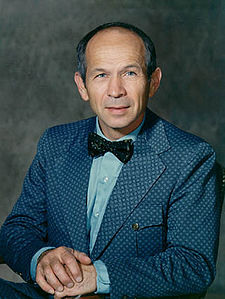
MAX-1 (Spacecraft)
Encyclopedia
The MAX-1 is a manned spacecraft being developed by Copenhagen Suborbitals
. The MAX-1 is designed to be similar to the Mercury spacecraft.
For decent it uses a parachute which deploys from the top of the spacecraft
. The ingress/egress hatch is placed above the head of the astronaut and can be opened and closed from both the inside and outside using 8 pneumatic cylinders. MAX-1 will be produced in aluminium
.
 The MAX-1 is named after American rocket engineer Maxime Faget
The MAX-1 is named after American rocket engineer Maxime Faget
.
Copenhagen Suborbitals
Copenhagen Suborbitals is a non-profit organization working towards suborbital manned spaceflight. Founded in 2008 by Kristian von Bengtson and Peter Madsen the project has accomplished a successful sea launch of a test hybrid rocket, carrying a full scale human model...
. The MAX-1 is designed to be similar to the Mercury spacecraft.
For decent it uses a parachute which deploys from the top of the spacecraft
Spacecraft
A spacecraft or spaceship is a craft or machine designed for spaceflight. Spacecraft are used for a variety of purposes, including communications, earth observation, meteorology, navigation, planetary exploration and transportation of humans and cargo....
. The ingress/egress hatch is placed above the head of the astronaut and can be opened and closed from both the inside and outside using 8 pneumatic cylinders. MAX-1 will be produced in aluminium
Aluminium
Aluminium or aluminum is a silvery white member of the boron group of chemical elements. It has the symbol Al, and its atomic number is 13. It is not soluble in water under normal circumstances....
.
Basic Data
- Mass: 350 kg (including astronaut)
- Length: approx. 4 meters
- Diameter: 64 cm
- Internal atmosphere: 1 bar, atmospheric gas
- Pressurized volume: approx. 600 liters
- Unpressurized volume: N/A
- Parachutes: 3 (1 drogue + 1 pilot + 1 main)
- Parachute data: cross type, 145 sqm total
- Heat-shield: N/A
- Communication: N/A
- Tracking: N/A
- Power profile: 12/24V DC
- GNC profile: IMU system
- Coding protocol: RS422
- Additional info: Personal parachute for panic egress.
Naming

Maxime Faget
Maxime "Max" A. Faget was the designer of the Mercury capsule, and contributed to the later Gemini and Apollo spacecraft as well as the Space Shuttle.- Life :...
.

